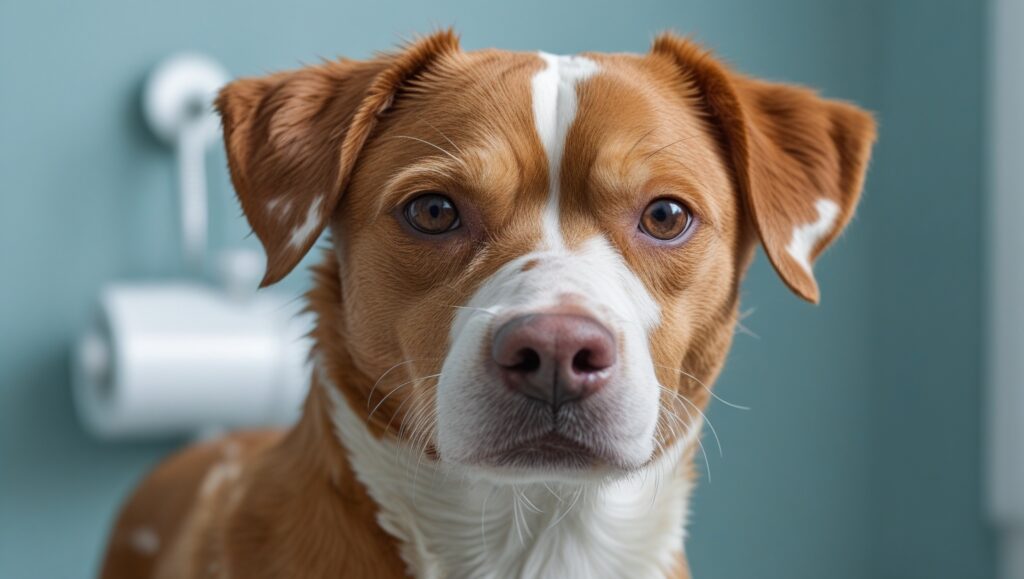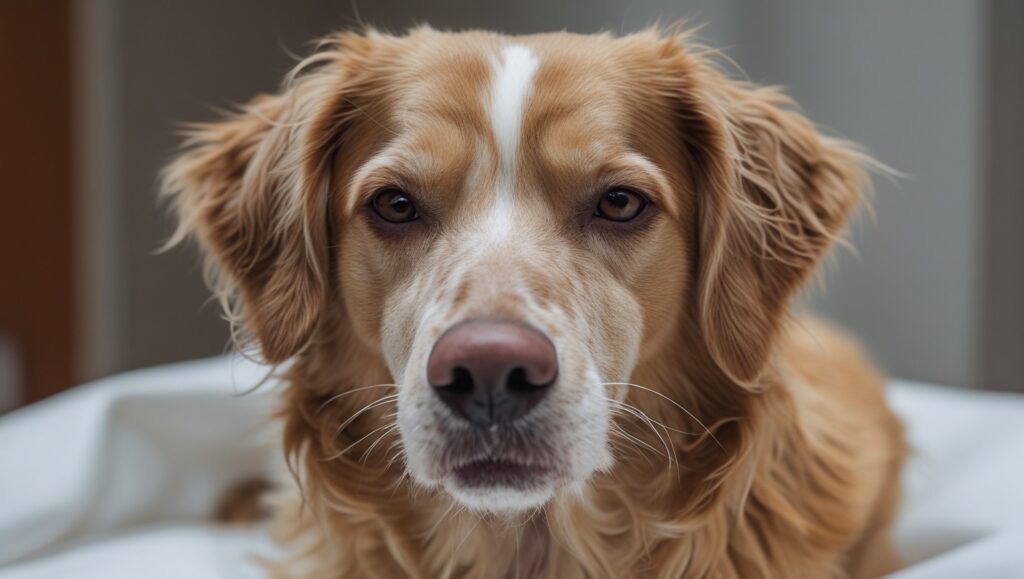Dog pyoderma can also be termed as the prevalent and frequently arising case of bacterial infection of the skin that leads to the appearance of the lesions that are filled with pus, causing redness and irritation. In the given article, you will find the pictures of pyoderma in dogs and learn what the cause of this illness in dogs is, what types exist, what symptoms it has, and how dogs can be cured.
Table of Contents

What is Pyoderma in dogs?
Pyoderma means ‘pus on the skin’. It is a canine bacterial skin infection that is caused by staphylococcal bacteria which is the common occurrence of staphylococcal bacteria becoming infected at broken skin or irritating skin. This is either shallow or deep and is mostly in breeds such as Bulldogs, pugs and Shar-Peis whose coat has skin folds.
There are three types of pyoderma in dogs (illustrated)
Pyoderma in dogs has multiple types, and each of them has its own appearance and the level of its severity. The major types are described below, with a description of their appearance:
1. Superficial Pyoderma in the Dogs
It is the most widespread type, which develops on the surface of the skin. It comes out as:
- Red rings of patches.
- Pustules (small bump-like and filled with pus).
- Crawling or crusty sores.
- Baldness of bald patches.
Visual Clue: The dandruff or flaky skin that may be red could appear when superficial pyoderma is likely to be formed.
2. Deep Pyoderma
When the infection penetrates deeper into the skin, the following happens:
- Big, swollen lumps.
- Ulcerative lesions, Painful lesions.
- Wound drainage Wound drainage.
- Lesions are surrounded by swelling and heating up.
Visual Clue: Deep defect has the appearance of oozing with pus in open wounds or red colour that is severe.
3. Intertrigo pyoderma of the skin folds (pyoderma)
This type is typical among the wrinkled or folded dogs (such as the Bulldog or the Cocker Spaniel breed) and finds a moist area between skin folds.
- Foul smell
- Damp skin of a reddish colour.
- Yellowish discharge
- Intense itching
Visual Clue: Red moist areas between skin folds or under armpits.
Aetiology of Canine Pyoderma
Pyoderma obtains its secondary origin as a condition. Some of them are as follows:

- Environmental or food-related allergies.
- Mites or fleas
- Such endocrine pathologies as hypothyroidism or Cushing’s.
- Bad hygiene/grooming.
- Lick tumour or licking injury.
- Immunodeficiency
The chances of developing pyoderma are especially at those dogs whose immune systems are compromised or dogs that otherwise have a tendency of developing skin infections.
Doggy Pyoderma Signs and Symptoms
In addition to the manifestation of skin lesions, there are:
- Profuse scaling and scratching.
- Patchy loss of hair.
- Flaky Skin or Crusty Skin.
- The odour of unpleasant skin odour.
- Blood and puffiness.
- Harm from being touched.
When you notice these symptoms together with these lesions that resemble the pictures of pyoderma in dogs, go to the vet as fast as possible.
Diagnosis: The Way Vets Diagnose Pyoderma
A veterinarian can carry out:
- The skin scraping/cytology: This can be done to study bacteria through a microscope.
- The culture test: to determine the particular bacteria
- Blood tests: in case an inductive condition, such as hypothyroidism, is assumed
When diagnosed correctly, there will be specific treatment.
Therapy of Pyoderma in Dogs
Pyoderma would incorporate treatment:

1. Topical Treatment
In gentle or superficial:
- Chlorine medicated shampoos.
- Antibacterial sprays or cream inserts.
- Routine washing to maintain the body skin clean.
2. Oral Antibiotics
Moderate and severe cases:
- Three to six weeks prescriptive period.
- Momentous to go through the entire course.
3. Medication of the Causes
Treat minor diseases such as allergies, parasites or hormone imbalances so that they do not happen again.
4. Food and supplements
Skin can be reinforced with the reinforcement of omega-3 fatty acids, zinc, and a balanced diet.
Prevention of Pyoderma Recurrence
When your dog has recovered, this is how to prevent a flare-up hereinafter:

- Groom folds regularly.
- Hypoallergenic products should be used when bathing.
- Prevent and treat flea and tick parasites with preventatives.
- Do not overbathe because it washes away natural oils.
- Treat allergies under veterinary advice.
- Feed immune-enhancing dietary food.
A frequent examination of your dog may allow you to notice that something is wrong, and you will be able to stop the process before any severe consequences have happened.
The time when you should call a vet: 14 Signals that it is Time to Take your Pet to see the Vet
When you pay attention, you see:
- Not better after 12 or 2 weeks of treatment.
- Recurring infections
- Deep lesions or open sores.
- Signs of being in pain or fever.
Seek instant veterinary assistance. The unattended pyoderma may progress to deeper infections, or it may spread to other parts of the face.
Differentiating Pyoderma from Other Dog Skin Problems
A lot of different dog skin problems and diseases- such as mange, fungal infections or allergies- may resemble pyoderma. Pyoderma in this case is unique however in this case.
- Pyoderma: pustules, red circular patches, pus, and scabs.
- Mange: It is an issue of mites. Mange leads to loss of hair and itching as also.
- Fungal infections: It is not uncommon that fungal infections entail ringworm-like rings.
- Allergies: They are normally characterised by itchiness and non-use red spots.
Failure to recognise, you can go through the symptoms and compare them to the images of pyoderma in dogs and visit a vet to give a correct diagnosis.
More Susceptible Breeds of Pyoderma
There are specific breeds that are prone to scratching, skin structure, or immune system issues:

- Bulldogs and Pugs: Because of woolly skin folds.
- Golden Retrievers and Labrador Retrievers: Sensitive to allergies that result in secondary infections.
- Shar-Peis: characterised by deep wrinkles and sensitive skin.
- Cocker Spaniel: Localised pyoderma may be caused by ear infections and wet spots.
In case your dog is one of these breeds, it is strongly advised to have regular check-ups.
How to Take Care of a Dog with Pyoderma?
It is equally essential that you care about your pet in case of recovery as much as the medical treatment:
- Avoid letting your dog lick or scratch the infected parts.
- Apply an Elizabethan collar (E-collar) in case of necessity.
- Wash beddings and grooming materials.
- Sheet homoeopathic/low-stress healing environment.
Conclusion
The pictures of pyoderma in dogs is an uncomfortable yet curable illness. Whether it is only superficial pyoderma on dogs, skin fold infection or deep bacterial lesions, it can be diagnosed at an early stage by a picture of pyoderma on dogs that will help the pet owner to take action on time. To accomplish this, you have to ensure that your dog gets the appropriate veterinary treatment, improve its hygiene practices and get rid of the conditions which predispose it to the infection so as to have healthy skin and be free of the infection.
Does pyoderma in dogs spread to human beings and other pets?
Not usually, most types of pyoderma are not contagious. The bacteria causing it (such as Staph) can, however, be dangerous to immunocompromised patients.
How long does the treatment of pyoderma in dogs last?
Marginal cases can be healed after a couple of weeks by means of topical treatment, whereas deep infections may require 6 to 8 weeks of oral antibiotics.
Is it possible to cure dogs with pyoderma using the home remedy?
Although a weak cleaning with antiseptics can alleviate the problem, you should not stop at home remedies. A vet should always be consulted in order to get treatment and a diagnosis.




Pingback: 10 Best Friend Dog Quotes That Capture True Loyalty & Love